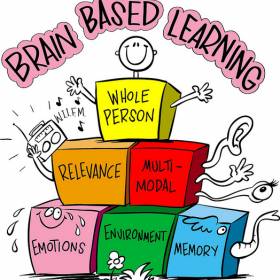
Brain Based Learning & Teaching

Fundamental Concepts in Brain-Based Teaching
Brain-based research has resulted in several principles of learning that form the underlying principles of brain-based educational practices. We now know that all learning is mind-body, and attention cycles, movement, food, and chemicals all impact on learning. People learn best in a social setting, and as they seek out meaning they use their emotions to form patterns, pay attention, and remember material. The brain stores information in several areas, and this information can be accessed through multiple pathways. In addition, the brain can carry out a number of activities simultaneously.
Incorporating Newer Educational Concepts
The classroom of today is different from the classroom of several years ago. Students now learn in cooperative groups, and they are given problems to work on. Teachers attempt to give students practical simulations that mimic real life, therefore making the learning experience more meaningful. In addition, educators take into consideration multiple intelligences, recognizing that although some are visual learners, others may do better with educational experiences that play into intelligences such as interpersonal, intrapersonal, kinesthetic (movement), linguistic, logical, musical, and naturalistic. Experiential learning, in which the learning is initiated by the student and is relevant to his or her life, is also used in the classroom. All of these methods are based on our current understanding of how the brain functions and learns. (Penn, nd)
By: Sharon Penn (http://www.ehow.com/about_6502830_brain_based-learning-teaching.html)
News
Discussions
23.01.21.03.10.52 © 2025 Pearce, LLC
 Group owner:
Group owner: